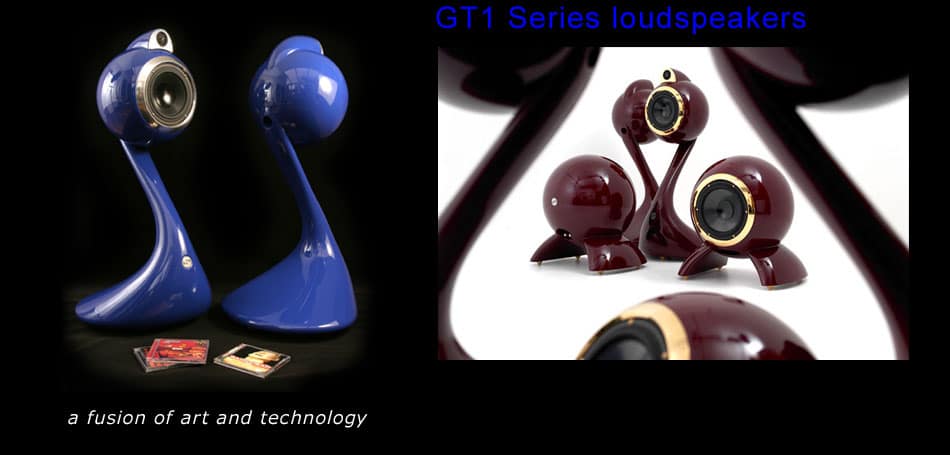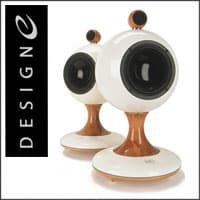Design e
The first time I came across Design e loudspeakers was at hi-fi dealership, Phonography, in Ringwood, Hampshire (see www.phonography.co.uk). Phonography has integrity, as in the recent past, formerly very lucrative manufacturers have been taken off their roster when their latest products failed the musicality test. So it was with shock as I gazed upon some rather beautifully styled Design e GT3 loudspeakers in the showroom; being somewhat more avant-garde than the everyday combination of MDF & wood-veneered box. I had to investigate…
Design e was formed in 1996 and is headed by Ian Webster and Hugh Tomlinson who have previously collaborated on design projects dating back to the late 1980s. Ian is responsible for the aesthetics and manufacturing requirements, while Hugh is in charge of all the technical aspects.
Here, Ian provides some background and answers questions about his design philosophy and manufacturing:
***************
Can you give a brief account of your design experience?
My appreciation of high-quality designs comes as no surprise considering that my father (Eric Webster) was a renowned textiles designer during the 1960s and 1970s. He was responsible for designs such as the original Fred Perry logo amongst others. The family home contained an extensive range of design classics, fast cars and more than its fair share of musical experiences. Designs were allowed to enter the home on merit alone and the intoxicating effect of a prestigious brand was patently ignored. …These influences have had a significant affect on my development and in turn the ethos of Design e.
(This) passion for design and performance resulted in me attending the world famous degree course for automotive design at Coventry University. This renowned course has been attended by many of the influential UK designers working in design studios all over the world and provides a sound basis for career development. It also offers an interesting melting pot of ideas and philosophies that can result in some inspired concepts. One of the lecturers on the course at the time was Simon Saunders, the man who later went on to be responsible for the innovative Ariel Atom (see www.arielmotor.co.uk).
Once I had completed the course, I honed my skills working my way up to principal designer for a pioneering design consultancy. I then went on to work on design concepts for larger manufacturers including Mitsubishi and Ford. My desire to enjoy a wide range of design work outside the automotive sector and to oversee the whole design process from beginning to end resulted in the creation of my own design consultancy. This enabled us to work on a wide range of projects including specialist British manufacturers such as The Light Car Company (manufacturers of the highly praised Rocket car) and to enjoy the new challenges that this move provided.
We were also drawn into the arena of loudspeakers, which provided huge scope to focus my passion for good design and great performance. The automotive world entices customers with evocative forms and stunning performance and I believe loudspeakers can do the same. Very quickly we channelled our enthusiasm and drive into producing our own designs. I believe that our designs have had a considerable impact on the market...
We aim to produce designs that look as good as they sound and I personally inspect every pair of loudspeakers before they are shipped to the customer. I would like our designs to raise a smile on the owner’s face whenever they go near them, in a similar way to the effect of stepping into their favourite sports car…
Loudspeakers: GT1

What material is used for the main GT1 enclosure and why?
The enclosures are made from a (confidential) composite material that has a consistent 5mm wall thickness. The enclosure is a single monocoque construction that (as the automotive industry is well aware) is chosen because it provides excellent strength and rigidity. The enclosures are then finished with a high performance isocyanite cured acrylic coating, which enables us to provide an (optional) exact colour match... The bezels are CNC machined from an aerospace grade aluminium alloy billet and then chrome or gold plated.
What is the construction of the tweeter? And why were these particular materials used?
The high quality tweeter unit has a 28mm hand treated cloth dome (similar to the GT3, but higher specification) and incorporates a neodymium magnet system that provides a very linear and wide frequency response. It is a compact unit that was chosen because of its excellent integration with the other two units.
What is the construction of the mid/bass driver in the GT1? And why were these particular materials used?
The mid/bass driver is a 6.5inch unit (similar but superior to the GT3) that utilises a sandwich cone construction. It was chosen because it can provide excellent performance as a mid/bass unit in its own right, or as the perfect complement to the (sandwich cone) 8inch bass unit (within the Bass-Enhancer Loudspeaker). (The 8inch driver) was chosen because it was designed to work specifically with the 6.5inch unit, as you can hear when you listen to the 4 set arrangement.
Why doesn’t the GT1 cabinet use any wool/damping material within its main enclosure?
The interior of the housing has no damping material for the same reasons as the GT3s. There is a port in the rear of the satellite unit and a port in the front of the Bass-Enhancer unit and they are both wrapped in damping material (see below).
The GT1s have been designed with flexibility in mind – A customer can purchase the GT1 series satellite units alone and enjoy the stunning looks and excellent performance in their own right. (Then) the customer can come back to Design e and purchase the Bass-Enhancer units, if they have a much bigger room or just want the enhanced performance.
At this point we will replace the crossovers in the satellite units to provide optimum performance. This is done at no extra cost to the customer. The GT1s are in my opinion a genuinely iconic design. …I think you can clearly see the influence they have had on other manufacturers. This is not a statement I make lightly…
GT3 Stand Mount Loudspeaker (£745) / What is the material used for the GT3 enclosure and why?
The material used for the enclosure is polyurethane and it was chosen because the manufacturing process has provided the GT3s with a consistent 8mm wall thickness and excellent surface finish.
What material is used for the uprights, tweeter housing and undercarriage of the plinth and why?
Solid oak was chosen to contrast and complement the polyurethane. The high quality finish and appealing aesthetics enable the GT3s to integrate into homes in a similar way to a classic piece of furniture, such as an Eames chair, etc.
Why does the cabinet not use any wool/damping material within its main enclosure? And also what material does the port have wrapped around it and why?
Hugh’s research demonstrated that the sphere eliminates a lot of the problems associated with the traditional oblong box loudspeaker housings. This also revealed that dampening material wasn’t needed and the quality of sound is enhanced by the clean interior of the housing. The port has some dampening material around it because it is the only long straight piece in the spherical housing. Hugh therefore decided that it would benefit from the dampening material and testing proved him correct.
Can you name your five favourite albums and why?
Radiohead, ‘The Bends’ (1995)
In a time where mediocrity is frequently hyped beyond all recognition, I was shocked and more than pleasantly surprised to discover that ‘The Bends’ is indeed as good as the pundits reckoned. Thom Yorke’s amazing vocals work perfectly with the intensely haunting melodies to produce what I consider to be a real musical masterpiece. It is easy to see and hear the influence that this album has had on future bands and yet for me it remains as fresh and compelling today as when I first heard it.
Paul Weller, ‘Wild Wood’ (1994)
I always try to keep this album close to hand, which can be tricky when you have a two year old that likes to file any treasured objects in safe places that only she is aware of… This wonderful album comes across as the result of someone enjoying (or rediscovering the joy) of their talent for creating great music. It has an earthy and natural sound that is catapulted up another level by his spirited and engaging performances.
Van Morrison, ‘Moondance’ (1970)
This album seems to have shadowed me throughout my life and evokes many happy memories. It’s not a bad musical collection to be haunted by either and just imagine how differently you’re view of the world would seem if at pivotal moments in your life you kept hearing tracks from Westlife, or Mariah Carey… I know that many people consider ‘Astral Weeks’ his best work, but I prefer the warmth and energy that can be found in ‘Moondance’, even without the memories associated with it.
Nick Drake, ‘Five Leaves Left’ (1969)
Nick Drake was a well-hidden secret from me until I was introduced to him at University. My ignorance was fully revealed by the fact that I thought he was a new artist and I guess this is a testament to the timeless quality of his music. The understated beauty of his voice compels you to listen and the eloquence of the musical composition leaves me stunned every time I listen to the album.
Madeleine Peyroux, ‘Half The Perfect World’ (2006)
I’m now at a stage in my life where the ability to listen to a captivating female voice in a raw and untainted form can provide an oasis of peace and calm... Madeleine Peyroux certainly ticks all the boxes and leaves me feeling satisfied in a way that Norah Jones and Katie Melua just can’t compete with. There are lots of comparisons with Billie Holiday and the like, but I just find myself enjoying the beautiful music she creates and that’s the whole point isn’t it?
As you can see from Ian’s statements and answers, Design e is a company that stands out from the loudspeaker norm. Indeed, I have heard the GT1 and GT3s in different systems and via a wide variety of music by the likes of Bartok, Joe Satriani, The Cardigans and Kraftwerk. With all these different genres, the Design e loudspeakers were very revealing and yet so effortlessly musical; with excellence in timing, rhythm and phrasing. Thus their inherent musicality was evident even in the solo piano recording from ‘Liszt: Sonata and Etudes’ (2006) by George-Emmanuel Lazaridis, where the piano was convincingly three-dimensional and excellent in impact and definition.







